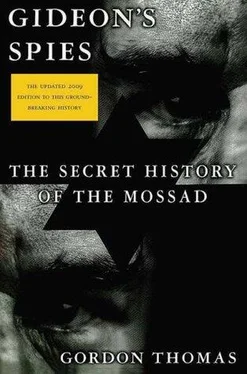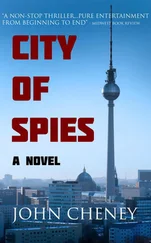Gordon Thomas - Gideon's Spies
Здесь есть возможность читать онлайн «Gordon Thomas - Gideon's Spies» весь текст электронной книги совершенно бесплатно (целиком полную версию без сокращений). В некоторых случаях можно слушать аудио, скачать через торрент в формате fb2 и присутствует краткое содержание. Город: New York, Год выпуска: 2009, ISBN: 2009, Издательство: Thomas Dunne Books, Жанр: История, на английском языке. Описание произведения, (предисловие) а так же отзывы посетителей доступны на портале библиотеки ЛибКат.
- Название:Gideon's Spies
- Автор:
- Издательство:Thomas Dunne Books
- Жанр:
- Год:2009
- Город:New York
- ISBN:978-0-312-53901-6
- Рейтинг книги:4 / 5. Голосов: 1
-
Избранное:Добавить в избранное
- Отзывы:
-
Ваша оценка:
- 80
- 1
- 2
- 3
- 4
- 5
Gideon's Spies: краткое содержание, описание и аннотация
Предлагаем к чтению аннотацию, описание, краткое содержание или предисловие (зависит от того, что написал сам автор книги «Gideon's Spies»). Если вы не нашли необходимую информацию о книге — напишите в комментариях, мы постараемся отыскать её.
Gideon’s Spies
Gideon's Spies — читать онлайн бесплатно полную книгу (весь текст) целиком
Ниже представлен текст книги, разбитый по страницам. Система сохранения места последней прочитанной страницы, позволяет с удобством читать онлайн бесплатно книгу «Gideon's Spies», без необходимости каждый раз заново искать на чём Вы остановились. Поставьте закладку, и сможете в любой момент перейти на страницу, на которой закончили чтение.
Интервал:
Закладка:
As with the original edition, much of the subsequent updating has remained until now beyond the public domain. In part I was lucky in having my late father-in-law as an officer in MI6 during the Cold War; that connection made it easy to break down the understandable wariness the intelligence world has of outsiders asking questions, the more so when the answers are not always easy to present fairly. At times though, that reticence opened some doors as agents and their controllers saw the opportunity to explain themselves. Among those I spoke to were William Casey, the CIA director; Meir Amit, the director-general of Mossad; Rafi Eitan, its celebrated director of operations; and Marcus Wolff, a former head of Stasi, the East German intelligence service. The names of others, who still serve, will have to remain anonymous. But to them, in particular, I express genuine gratitude; without their help it would have been impossible to update this account of Mossad.
The time frame of some of their recollections falls somewhere between recent history and fading memory. But what was so remarkable, and rewarding, was how time and again an interviewee would go to great trouble to check his personal recall with official records and a wide variety of private material. In the beginning I had wondered what motivated them to provide such cooperation. One day, as I was walking through Rafi Eitan’s garden in a break between filming his recollections, he suddenly turned to me and said: “I don’t want anything for my help except the guarantee you will present only the facts. And if you can convey the most important fact of all, that intelligence has changed dramatically in the past twenty years with the end of the Cold War and the collapse of Soviet Communism, I will be satisfied.” He had paused, looked at me and smiled, flexing his hands. “You fail to do that and I won’t be happy.”
Field agents, analysts, divisional directors, and several department heads of Mossad all contributed their insights into how Mossad works, its decision making process, its relationship with other services. This has enabled me to write accurate stories about Mossad for reputable newspapers and magazines. Some of those accounts have not been flattering.
Since the original edition was published in 1996, new information on Mossad has continued to be passed to me. Some of it came in the form of leaks. I had long learned that Mossad, along with other secret services, likes to get its side of the story out. In all the time I have dealt with its employees, I cannot say a leak has ever been misleading. Nevertheless, the golden rule for my kind of investigative work is enforced: check and check again. I cannot recall an example where my original source had not told the truth.
Since the book was first written, Mossad, like all intelligence services, has found itself confronting new challenges. The end of the Cold War found that while superpower confrontation had vanished, the new world order required a new role for spies. Mossad, like the CIA, MI6, and all the major intelligence services, found itself having to counter drug running, terrorism on an unparalleled scale, and economic espionage. At the same time, Mossad was determined to maintain its position as the one service that still insisted on a prime role for its human spies as a complement to the satellites and the other exotic systems to counter the threat posed by Osama bin Laden.
The milestones along his road to become the evil guru of terrorism were those he exploited: Guantanamo, Abu Ghraib, the failure of the Oslo Accord, the second Intifada , the suicide bombers, the wars in Iran and Iraq.
In September 2006, thereafter, and for the foreseeable future, Osama bin Laden continued to solemnize the suicide bombers with their body belts of explosives, their car bombs, truck bombs, bombs powerful enough to topple buildings and the concrete bunkers which proved no defense against the explosions. He continued to encourage mothers to give their children up to martyrdom. He told them, in that soft, certain voice that seemed to come from deep within him, that martyrdom was the only way a Muslim could bypass the painful interrogation that awaits us all on the Day of Judgment and proceed directly to heaven immediately transported to Allah’s garden where the celestial virgins awaited. Emerging from the al-Qaeda training camps in Afghanistan, the northwest frontier of Pakistan, the mountains of Iran, and the deserts of the Yemen, the martyrs went to their deaths convinced of the purity of their cause.
Against such an enemy Meir Dagan was among many who said there was no more formidable foe. By 2006, a year that saw more suicide bomber attacks than in previous years, the art of mass murder had been refined with the use of new combinations of explosives, sharper nails and nuts and bolts. In May of that year there were more human bombings in Iraq than during the entire first Intifada . From a city, London, that had witnessed the effect of suicide bombers in the July bombings, 2005, came the view of its then-mayor, Kenneth Livingstone: “Given that they don’t have tanks, they only have their bodies to use as weapons, in an unfair balance that’s what people use.” Such encouragement can only have pleased Osama bin Laden. And just as those many millions still believed the CIA had been the instrument that triggered 9/11, so many others accepted Livingstone’s judgment, one that was widely reproduced across the Islamic world.
The rise of al-Qaeda in so short a time is one of the more startling aspects of the closing decade of the twentieth century. It was a brilliantly executed conversion of millions of hearts and minds, first across the Middle East, then into Asia, and the Muslim rump of the old Soviet Union. From there it was but a leap into the depths of Africa, from the deserts of Sudan down to the shores of the Cape of Good Hope. At the same time bin Laden’s apostles began to proselytize in Latin America, promising the impoverished of that continent a better way of life awaited them in the new Caliphate bin Laden had insisted was coming. The United States and Canada also became fertile grounds for ensnaring the disenfranchised. By then a Mossad analysis indicated, Europe may have attracted “possibly a million” sympathizers for al-Qaeda’s aims to bring about a new world where corruption, perversion, prostitution, and all other Western vitiation would be excised. People who were dissatisfied with the failure of organized religion and an unequal way of dispensing justice were drawn to the stark principles of Sharia Law.
In their offices the analysts of Mossad, like those in other intelligence services, tried to predict how this would play out in the closing quarter of 2006. Much would depend on what happened in Iraq. The signs had never been good since the Bush administration, supported by Tony Blair, had made the monumental mistake of not paying close attention to the history books. Baghdad had been the spiritual seat of the original Caliphate. To attack it was an offense in the eyes of Osama bin Laden only rivaled by an assault on Mecca. In his speeches he had often spoken of “the joy of meeting the Infidel in the Land Between the Rivers”—the Euphrates and the Tigris which bisect Iraq. It is now his frontline, a place where his jihadists roam, showing the occupiers it is no longer the “slam dunk” (Tenet) or a “cakewalk” (Rumsfeld). If the original reason for the invasion—to remove the tyranny of Saddam Hussein—was in many ways an honorable one, it lacked a plan for what would follow. Now as the United States and a reluctant coalition of NATO troops struggled to pacify the Taliban in Afghanistan, the bodies in the streets of Baghdad—sixty-five found murdered on one day in September—continued to accrue.
Yet in his weekly morning conference Meir Dagan had warned his heads of department that Iran was now a priority for intelligence gathering in preparation for an aerial assault on its nuclear facilities.
Читать дальшеИнтервал:
Закладка:
Похожие книги на «Gideon's Spies»
Представляем Вашему вниманию похожие книги на «Gideon's Spies» списком для выбора. Мы отобрали схожую по названию и смыслу литературу в надежде предоставить читателям больше вариантов отыскать новые, интересные, ещё непрочитанные произведения.
Обсуждение, отзывы о книге «Gideon's Spies» и просто собственные мнения читателей. Оставьте ваши комментарии, напишите, что Вы думаете о произведении, его смысле или главных героях. Укажите что конкретно понравилось, а что нет, и почему Вы так считаете.












